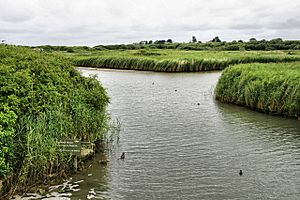Titchfield Haven facts for kids
| Site of Special Scientific Interest | |
 |
|
| Area of Search | Hampshire |
|---|---|
| Interest | Biological |
| Area | 134.5 hectares (332 acres) |
| Notification | 1983 |
| Location map | Magic Map |
Titchfield Haven is a really special place for nature, covering about 134.5-hectare (332-acre) of land. It's located north-west of Gosport in Hampshire, England. This area is so important for wildlife that it has several special protections. It's a Site of Special Scientific Interest (SSSI), which means it's a top spot for plants, animals, or geology. Most of Titchfield Haven is also a Local Nature Reserve and a National Nature Reserve, showing how valuable it is for conservation. It's even part of bigger protected areas called a Ramsar site and a Special Protection Area, which are important for wetlands and birds around the world.
Contents
A Look Back: How Titchfield Haven Was Made
For a long time, up until the late 1500s, the River Meon was wide enough for ships to sail all the way to Titchfield. Back then, Titchfield was a busy port. But over time, the river started to fill up with mud and sand, making it hard for ships to pass.
To keep Titchfield as an important port, the Earl of Southampton decided to build a canal. This new waterway, called the Titchfield Canal, opened in 1611. It was one of the very first canals ever built in Britain!
Sadly, the canal also started to fill with mud, just like the river. Because of this, sea trade eventually moved to bigger nearby ports like Southampton and Portsmouth. As part of building the canal, a dam was put in place where the River Meon met the sea. This dam stopped the salty seawater from coming in, turning the area into the freshwater wetlands we see today. These wetlands are now the amazing nature reserve.
Wildlife and Nature at Titchfield Haven
Titchfield Haven used to be a place where salty seawater flowed in and out with the tides. But now, thanks to special one-way valves, it's mostly freshwater. This means it has rivers, marshes, wet meadows with ditches, and fen areas. It's a super important home for birds that like to breed in wetlands. You might spot birds like bearded reedlings, sedge warblers, and reed warblers here.
How the Reserve is Cared For
The people who manage Titchfield Haven work hard to make it perfect for wildlife all year round. For example, they lower the water levels after the baby birds have grown up. This makes the muddy ground show, which is full of tasty food for birds that are migrating (traveling long distances).
They also clear out some water areas to attract cool insects like dragonflies and damselflies. Special plants like frogbit and flowering rush are also encouraged to grow here because of how the water is managed. Other plants you might see include slender bird's-foot-trefoil and marsh mallow.
Animals You Might See
In the winter, Titchfield Haven is a safe place for many ducks, geese, and wading birds. In the summer, avocets, which are elegant wading birds, even come here to have their babies!
The Walkway Pond is a busy spot, home to many dragonflies, damselflies, moorhens, mallards, and different kinds of warblers.
Good news for water voles! These cute little creatures have been brought back to the reserve and the River Meon. This is part of a big project by the South Downs National Park, Hampshire & Isle of Wight Wildlife Trust, and The Environment Agency to help them thrive again.
Observing Wildlife
Titchfield Haven has several special buildings called hides. These include Cottage Hide, Meon Shore Hide, Knights Bank Hide, Meadow Hide, Pumfrett Hide, Spurgin Hide, Suffern Hide, and West Hide. From these hides, you can quietly watch the amazing local wildlife. Besides all the birds, you might even spot foxes and deer!
Visiting Titchfield Haven
Titchfield Haven is open most days of the year, from 9:30 AM to 5 PM in the summer and 9:30 AM to 4 PM in the winter. It's closed only on Christmas Day and Boxing Day (December 25th and 26th).
You'll need a ticket to enter, which you can get at the Titchfield Haven Visitor Centre. There's free car parking nearby, so it's easy to visit. The site also has toilets (including ones for wheelchairs), a tea room where you can grab a snack, a shop, and an exhibition in the Visitor Centre where you can learn even more about this fantastic place.

